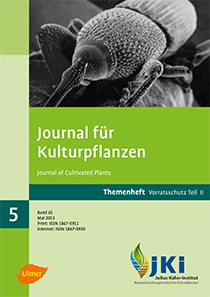Pheromones in Stored-Product and Material Protection – 35 Years of practical experiences
DOI:
https://doi.org/10.5073/JfK.2013.05.01Keywords:
Pheromone etymology, monitoring, faunistics, ecology, webbing clothes moth, Tineola bisselliellaAbstract
The application of pheromone baited traps to control pest insects in stored food or materials of use is well established since the past decades. The main pheromone components of all major stored-product and material pests have been identified. Pest monitoring with pheromone traps is a key factor in integrated pest management to estimate population density build-ups and to define economic threshold levels. Especially male attracting sex pheromones, e.g. for the stored-product pyralids, the clothes moths, and some anobiid beetles, function well in this aspect. Optimal control strategies in space and time are guided by pest population monitoring including efficacy evaluation of the undertaken control measures. Comparatively less successful is the application of aggregation pheromones, which are found in grain and flour beetles and which attract both sexes. Well functioning control of bark beetles through mass-trapping with aggregation pheromones in the forest environment could for various reasons not be implemented for stored-product protection, respectively.
Besides an economically driven adoption of pheromone traps, trapping results may also deliver useful information of a pest´s general ecology. The distribution of a pest species outside the synanthropic environment, its occurrence in hidden infestations out-doors can be estimated when monitoring tools are used out-doors, away from any storage facilities. The resulting autecological data can be helpful to detect natural reservoirs of a pest and to possibly reconstruct adaptation scenarios to the men-made environment.
Downloads
Published
Issue
Section
License
The content of the journal is licensed under the Creative Commons Attribution 4.0 License. Any user is free to share and adapt (remix, transform, build upon) the content as long as the original publication is attributed (authors, title, year, journal, issue, pages).
The copyright of the published work remains with the authors. The authors grant the Journal of Cultivated Plants, the Julius Kühn-Institut and the OpenAgrar repository the non-exclusive right to distribute and exploit the work.







